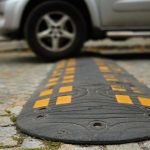Introduction
Traffic control speed bumps have become an essential part of road safety measures. As roads become busier and accidents continue to occur, finding effective solutions to reduce speed and prevent accidents is crucial. This is where traffic control speed bumps play a significant role. Designed to slow down vehicles and promote safe driving habits, they have proven to be a valuable tool in enhancing safety on the road.
Understanding Traffic Control Speed Bumps
Before we dive into the benefits of traffic control speed bumps, let’s define what they are and how they function. These are raised structures that are strategically placed on roads to control and reduce speed. They serve the purpose of promoting safety for all road users, including drivers, pedestrians, and cyclists. There are various types of speed bumps available, each with its own suitability for different road conditions.
Understanding Traffic Control Speed Bumps
Traffic control speed bumps are physical structures placed on roads to slow down vehicles and promote safety. They are typically installed in areas where speeding is a concern, such as school zones, residential areas, and parking lots. Speed bumps work by forcing drivers to slow down as they drive over them, reducing the overall speed of traffic in the area.
There are different types of speed bumps, including traditional speed humps, speed tables, and speed cushions, each with their own design and purpose. Traditional speed humps are longer and narrower, while speed tables are wider and lower, and speed cushions have gaps for emergency vehicles to pass through. The type of speed bump installed depends on the road conditions and desired speed reduction.
Overall, understanding the purpose and function of traffic control speed bumps is important in recognizing their benefits in promoting safety on the road. With proper installation and placement, speed bumps can effectively reduce speed and prevent accidents, making them a valuable tool for traffic control and safety.
The Benefits of Traffic Control Speed Bumps
Traffic control speed bumps offer numerous benefits in promoting safety on the road. Firstly, they serve as an effective way to reduce vehicle speed and prevent accidents. By forcing drivers to slow down, speed bumps create a safer environment for both drivers and pedestrians. This can also lead to the development of safer driving habits, ultimately reducing the number of accidents on the road.
The effectiveness of speed bumps in promoting safe driving is supported by various studies and statistics. In fact, a study by the National Highway Traffic Safety Administration found that speed bumps can reduce the number of accidents by up to 50%. This shows the significant impact that speed bumps can have on promoting road safety.
Furthermore, speed bumps play a crucial role in enhancing safety for all road users, including pedestrians and cyclists. By reducing vehicle speed, speed bumps can prevent collisions and injuries involving vulnerable road users. This is especially important in areas with heavy pedestrian traffic, such as school zones and residential areas.
Overall, the benefits of traffic control speed bumps cannot be ignored when it comes to promoting road safety. Their effectiveness in reducing speed, promoting safe driving habits, and enhancing safety for all road users make them a valuable tool in traffic control measures. With proper implementation and placement, speed bumps can make a significant difference in creating a safer road environment for everyone.
Enhancing Safety with Traffic Control Speed Bumps
Traffic control speed bumps not only effectively reduce vehicle speed, but also enhance safety for all road users. This includes drivers, pedestrians, and cyclists. By slowing down vehicles, speed bumps can prevent accidents and injuries, making roads safer for all. Studies and statistics have shown that speed bumps have a significant impact in promoting safe driving habits and reducing accidents.
Moreover, speed bumps play a crucial role in improving road safety in residential areas. By preventing speeding, they create a safer environment for families and children. When properly installed and designed, speed bumps can effectively reduce accidents and injuries. It is important to consider the placement and design of speed bumps to ensure maximum effectiveness.
With the implementation of traffic control speed bumps, we can enhance safety on our roads and protect all road users. While there may be concerns about noise and the impact on emergency vehicles, these can be addressed through proper planning and design. Many successful implementations of speed bumps have shown positive results in terms of promoting safety. It is time to consider implementing speed bumps as a solution for reducing speed and preventing accidents.
Implementing Traffic Control Speed Bumps
Installing traffic control speed bumps is a crucial step in promoting safety on the road. Proper placement and design are key to ensuring their effectiveness. Before installation, it is important to identify high-risk areas and consult with traffic experts to determine the most suitable type of speed bump for the location. This could include speed cushions, speed humps, or raised crosswalks. The installation process should also involve proper markings and signage to alert drivers of the upcoming speed bump. It is important to note that speed bumps should not be used as a standalone solution, but rather in conjunction with other traffic control measures. Regular maintenance and monitoring are also necessary to ensure the speed bumps are in good condition and serving their purpose. By following these steps, the implementation of traffic control speed bumps can effectively reduce speed and enhance safety on the road.
Addressing Concerns
Concerns about traffic control speed bumps are common, but many of them can be addressed and mitigated with proper planning and implementation. One of the main concerns is the impact on emergency vehicles, but there are solutions such as designing speed bumps with a gradual slope to allow emergency vehicles to pass over them smoothly. Additionally, noise can be a concern for residents living near speed bumps, but quieter materials and proper placement can help minimize this issue. It is also important to consider the type of road and the speed limit when installing speed bumps to ensure they are appropriate and effective. By addressing these concerns, traffic control speed bumps can still be utilized as a beneficial tool for enhancing safety on the road.
Conclusion
In conclusion, traffic control speed bumps are a valuable tool in promoting safety on the road. By effectively reducing vehicle speed, they help prevent accidents and promote safe driving habits. Studies and statistics have shown their effectiveness in improving road safety for all users, including drivers, pedestrians, and cyclists. Implementing speed bumps involves proper placement and design for maximum effectiveness, as well as addressing any concerns or challenges. However, these concerns can be mitigated and successful implementations have shown a significant impact on safety. As such, it is important to consider the use of traffic control speed bumps in appropriate areas to enhance safety and reduce accidents. Further research and consideration should be made in implementing speed bumps to continue improving road safety.








